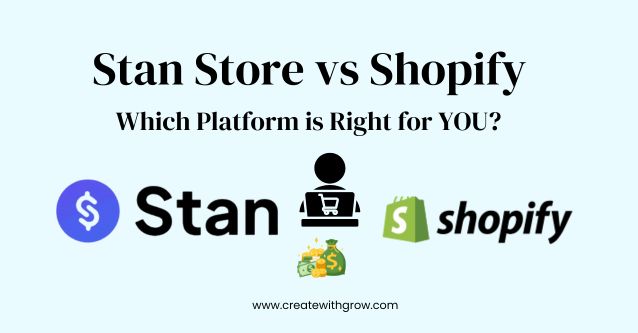Are you ready to start your online course journey but don’t know which platform fits your content and where to begin? The first big step is finding the right platform to host and create your course, often called LMS (Learning Management System) software. With so many different tools on the market, it’s understandable if you feel overwhelmed.
To help you get started, I’ve handpicked some of the Best Free Online Course Creation Platforms for you to explore. These platforms not only offer a range of features like intuitive course builders, quizzes and assessments, detailed student tracking, and even promotional tools, but they’re also beginner-friendly and won’t cost you a thing.
So, whether you’re brand new to the teaching scene or already have some experience, these free LMS platforms can help you bring your content to life and connect with eager learners. Sound exciting? Let’s dive right in.
6 Best Free Online Course Creation Platforms for 2025
Below are my top recommendations for the leading online course platforms this year.
What is a Free Online Course Creation Platform?
An online course platform, often referred to as a Learning Management System (LMS), is a digital solution, either software-based or hosted on the web, that enables you to build, oversee, market, and track your online courses.
Before Choosing a Free LMS Platform
With countless free LMS platforms available, selecting the right one can be challenging. Make sure to consider the following features before making your choice:
Course Availability
Check how many courses you can create with the free version. Many platforms let you create one to three courses, while a select few offer unlimited course creation.
Student Enrollment Limits
Look for platforms that allow unlimited student enrollments. Avoid those with strict enrollment caps, as they could limit your potential to scale.
Variety in Lesson Types
If you want to create interactive and engaging courses, ensure the platform supports diverse lesson formats, such as text, videos, audio, quizzes, and assignments. This variety helps keep learners engaged.
Transaction Fees
Finally, pay attention to transaction charges. Some platforms charge a fee every time a course is purchased. Opt for an LMS that keeps these fees low, helping you retain more of your earnings.
1. Thinkific Free Plan
Best Overall Online Course Platform
Thinkific is a well-known online course platform. It was founded by Gre in 2012 by Smith. If you want to create, promote, and sell your online courses without coding, Thinkific might be the one for you.
One of the coolest things about it is how much freedom you have to customize your courses and overall branding. Thanks to its handy integrations and thorough analytics, you’ll always know exactly how your courses perform. The best part? No coding skills are required; you can dive right in, even if you’re totally new to this.
Best For:
Everyone
Price:
Free, Paid Plan Starts From $36
Video Uploads
Yes 2 GB
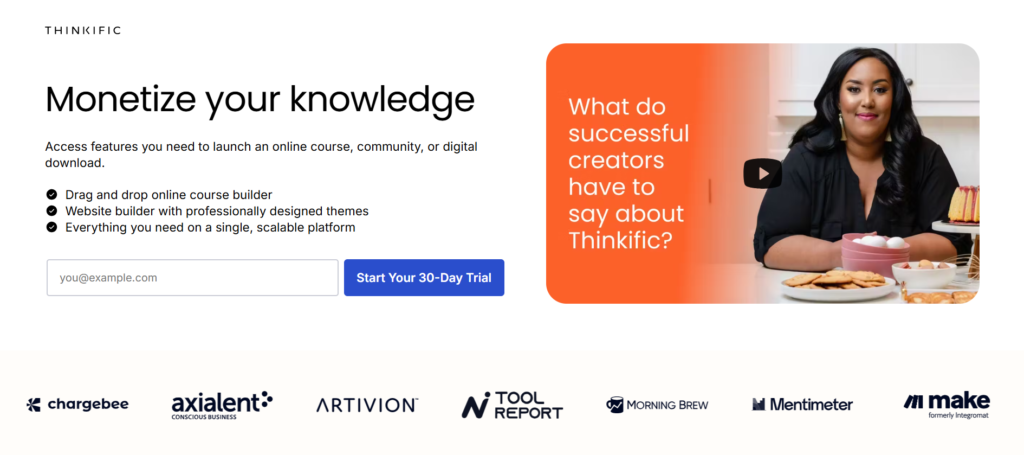
What’s Great About Thinkific
- No Limit on Students
Even with Thinkific’s free plan, you can allow as many students as you want; there are no caps. You don’t have to enroll them manually; they can sign up independently, which is a real-time save. - Variety in Lesson Types
Thinkific lets you spice up your courses with eight different lesson formats: Audio, Video, PDFs, Text, Downloads, Presentations, Multimedia, and Live Lessons. While it doesn’t support coding lessons, you still have a lot of ways to keep your content engaging. - Video Upload Freedom
With free hosting included, you can upload all your course videos straight from your computer. However, each video file cannot be larger than 2 GB. - Keep All Your Earnings
Another big perk is that Thinkific doesn’t charge transaction fees, even on the free plan. This means you keep every bit of your course revenue without losing a chunk to the platform. - Quizzes & Surveys
Thinkific’s free plan also includes quizzes and surveys. Quizzes are multiple-choice, and you can pick whether there’s a single correct answer or multiple correct answers. Surveys let you tap into learner feedback with various question types, from rating scales to open-ended responses. - Lots of Integrations
Thinkific’s app store offers over 45 free apps, including popular tools like MailChimp, ConvertKit, Constant Contact, Google Analytics, Facebook Pixel, Segment.io, Mixpanel, and Zapier. These apps make it easy to connect your course with your favorite marketing and analytics services. - Student Discussions
You can add a discussion area under each lesson. This encourages students to ask questions, share insights, and really connect with each other, making your course feel more like a community. - Attractive Themes
Want your school to look top-notch? Thinkific offers three nice-looking themes, so you can style your site to fit your brand. - Easy Landing Page Builder
Thinkific’s page builder has helpful elements for creating appealing landing pages. You can add countdown timers, testimonials, FAQs, banners, calls to action, and more to catch the eye of potential students and boost your conversions.
Where Thinkific Falls Short
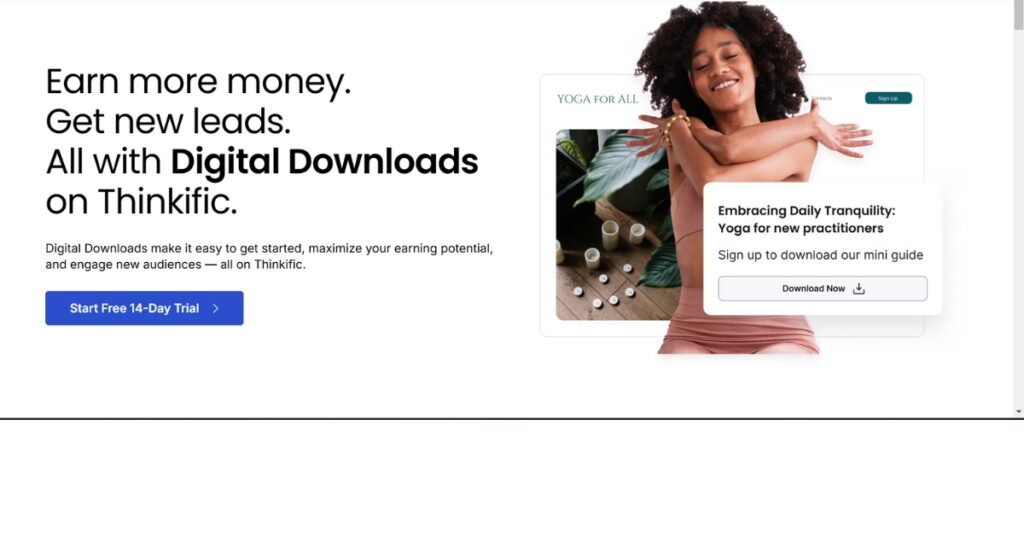
- Only One Course on a Free Plan
If you stick with the free plan, you’re limited to one course. This can feel restrictive if you want to expand your course library. - No Coding Lessons
If you primarily focus on coding tutorials, Thinkific doesn’t have a built-in solution for hosting coding exercises. You might need to look elsewhere or be creative with your delivery method. - Limited Payment Options
On the free plan, you can only offer your courses for free or at a one-time price. You’ll need to upgrade to a paid tier if you want ongoing subscriptions or monthly plans.
Demo Course Experience
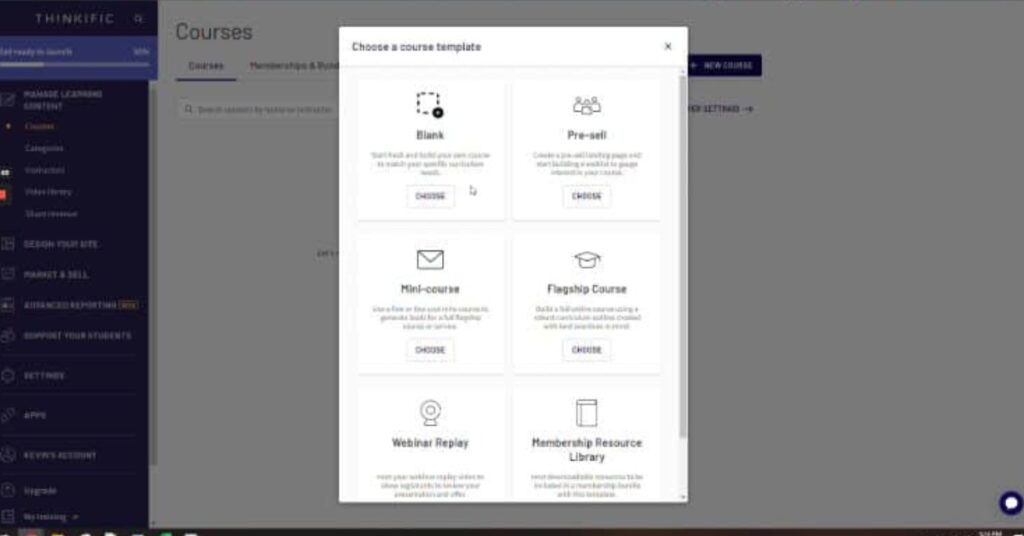
I tried out Thinkific by creating a demo course that included text, video, PDFs, quizzes, and even a survey. I loved how easy it was to gather feedback and engage learners. The quizzes, surveys, and landing page tools really stood out. If you’re curious, you can create a free Thinkific account and see how it fits your style.
Thinkific Pricing

Free 30-day trial ($0/month): This option is ideal for familiarizing yourself with the platform’s capabilities and understanding the overall user experience.
Basic ($36/month): Includes unlimited course creation and student enrollment, a single administrator account, scheduled (drip) content delivery, a custom domain, built-in email integrations, and coupon functionality.
Start ($74/month): Offers all Basic-level features and a single administrator account, plus the ability to create memberships and course bundles, host private courses, issue completion certificates, customize with advanced HTML/CSS, assign coursework, conduct live sessions via Zoom, and access priority customer support.
Grow ($149/month): Builds on the Start package with all Pro-level features, allows for up to three administrators, includes a dedicated onboarding package, and provides an unlimited growth package perfect for larger teams looking to scale.
2. FreshLearn
Best For Landing Pages
FreshLearn, launched by Rahul Mehta in 2020, is a platform designed to make it easy for you to create and sell online courses and other digital products. Whether you’re just starting out or you’ve been in the e-learning space for a while, it offers a wide range of features that can fit your needs.
Best For:
Everyone
Price:
Free, Paid plan starts at
Types of Lessons
Video, Audio, Doc, Live Lessons
Pros
- User-Friendly and Attractive Interface
Right from the start, FreshLearn feels inviting. Its modern, colorful look is pleasing to the eye and straightforward to navigate, which means you’ll likely pick it up quickly—even if you’re a complete beginner. - Multiple Types of Products Beyond Courses
FreshLearn isn’t just for online courses. You can branch out by selling digital downloads, running podcasts, hosting blogs, bundling products, and even offering master classes. This flexibility makes it easier to grow and diversify your business. - No Hidden Transaction Fees
One big relief is that FreshLearn doesn’t charge you any transaction fees, regardless of the plan you choose. This means more money stays in your pocket. - A Huge Library of Landing Page Templates
With 200+ customizable templates, you can build a landing page that perfectly reflects your brand. Adjust backgrounds, tweak colors, pick your favorite fonts, or add new content blocks—no design background required.
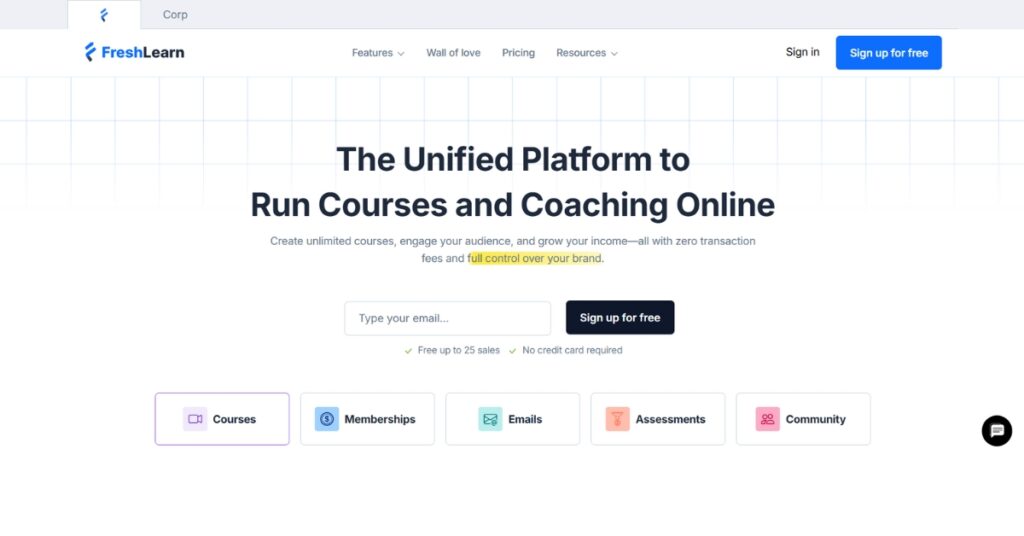
- Engaging Assessments to Keep Learners Interested
Spice up your courses with interactive assessments featuring single or multiple-choice questions. Plus, you can add things like lead forms, welcome screens, instructions, and results pages, making your quizzes feel more like an engaging learning experience rather than a dull test. - Coupon Codes for Promotions
Even if you’re on the free plan, you can create unique coupon codes to reward or attract new students. Set the discount type (percentage or fixed amount), limit how many times it can be used, decide when it expires, and choose which products it applies to. This gives you more control over your marketing strategy. - Flexible Drip Scheduling
You can schedule your lessons to go live after a certain number of days, on a specific date, or once a student completes a certain chapter. This helps keep learners engaged at a steady pace instead of giving them everything at once. - Easy-to-Use Email Marketing (Beta)
FreshLearn is testing email marketing tools that allow you to send up to 100 emails per campaign. While this might be a work in progress, it seems useful for staying connected with your students, reminding them of upcoming lessons, or promoting new content.
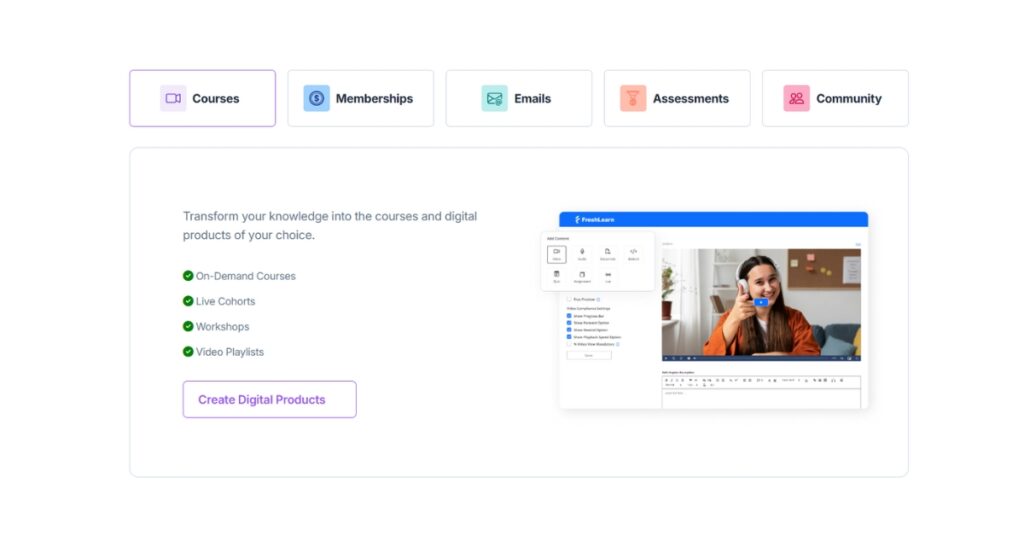
Cons
- Tight Enrollment Limits on the Free Plan
The free plan only allows up to 25 students, which can feel restrictive as your audience grows. Also, there’s no direct signup link for learners, so you’ll have to add them manually or upload them in bulk via a CSV file. This can be a bit time-consuming, especially if you’re expanding your customer base.
3. Teachable
Best Simple Online Course Platform for Beginners
Want to sell any of your digital work online? Consider checking out Teachable. Whether you’re looking to offer online courses, digital downloads, or host live webinars, Teachable provides a flexible platform that can grow alongside your business. You can even establish a community around your brand, ensuring that everything you need is conveniently managed in one place.
Best For:
Beginners
Price:
Free, Paid plan starts at
Types of Lessons
Video, Audio, Doc, Live Lessons
If you’re after a quick, straightforward course builder, Teachable stands out as an excellent option. It’s particularly ideal for newcomers eager to try their hand at creating and selling online courses. Plus, it’s one of the most affordable and user-friendly platforms on the market.
Teachable offers a free plan to get you started
Pros
1) Multiple Lesson Types
Teachable lets you present your course material in several formats, making engaging students in different ways easier. You can share your content through videos, PDFs, audio clips, text and images, banner images, and resource files.
The platform’s special coding lessons (with handy color coding) really stand out for those teaching tech subjects like computer science or web development. Remember, you won’t find live lessons or survey-style lessons available.
2) MCQ Quizzes
If you want to test what your students have learned quickly, you can set up multiple-choice quizzes. However, if you’re on the free plan, students’ quiz scores aren’t recorded, and you can’t explain the answers. It’s basic, but it still gets the job done.
3) Flexible Pricing Options
When it comes to selling your courses, Teachable is pretty flexible. You can offer your course completely free, set a one-time payment, break it down into a payment plan, or even subscribe. This allows you to choose what works best for you and your students.
4) Encouraging Student Interaction
Your students can leave comments on any lesson, making it easy for them to ask questions, give feedback, or spark conversations with other learners. This sense of community can help everyone feel more connected and engaged.
5) Security Features
Teachable takes security seriously. You can anonymize visitors’ IP addresses for privacy and add reCaptcha to the login pages to ward off spam and bots. It’s a small step, but it helps keep your platform safer.
6) Useful Analytics
When it comes to tracking your progress, Teachable’s got you covered. You’ll get reports on new sign-ups, sales, revenue, student activity, and lesson completions. These insights can help you see what’s working and where you might need to improve.
7) Basic Site Customization
Want your course site to feel a bit more like “you”? Teachable lets you tweak colors, change logos, add banners, and include different content blocks. Plus, you’ll have access to a couple of starter templates to help shape the look of your course pages.
Cons
1) Limited Student Enrollment
Recently, Teachable introduced a limit of just 10 students per free account. You must manually enroll them via email, and there are no direct student sign-ups. This is pretty restrictive if you’re hoping to grow quickly.
2) High Transaction Fees
Another downside is the transaction fees. Teachable takes $1 plus 10% of every sale you make. This can feel like a hefty cut for newcomers, especially when you’re just starting out.
3) No Built-In Emails or Integrations (on the Free Plan)
Finally, the free plan doesn’t let you email your students or connect with third-party tools (except for Stripe Payments if you’re in India). You’ll find this pretty limiting if you’re looking for smooth communication or marketing integrations.
4. PayHip
Best for Professional Features
PayHip is an online selling platform created by Abs Farah back in 2012, and it’s grown into a really flexible tool for anyone who wants to sell digital content and services. Whether you’re offering online courses, ebooks, memberships, or even physical items, PayHip makes it easy to share what you love with your audience.
Today, over 140,000 creators use PayHip to power their online businesses. The best part? It feels super simple to set up. You can jump right in without getting bogged down by technical details.
Best For:
Everyone
Price:
Free, Paid plan starts at
Types of Lessons
Video, Audio, Doc, Live Lessons
What’s Great About PayHip
- A Variety of Product Types
You’re not limited to just one type of product. PayHip helps you sell digital downloads, courses, memberships, and even physical goods, giving you the freedom to grow your business in many directions. - No Limits on Products or Customers
Even on the free plan, you can list as many products as you want and reach an unlimited number of customers. This really relieves the pressure when you first start out. - Engaging Course Content Options
Deliver a richer learning experience with different lesson types. You can mix and match text, videos, quizzes, surveys, assignments, and more. This variety helps keep your students interested and coming back for more. - Use Your Own Domain
Finding a free platform that lets you connect your custom domain is rare. With PayHip, you can. This means you can keep your branding consistent and look more professional right from the start. - Built-In Marketing Tools
Promoting your courses or digital products is easy here. With referral links, coupons, affiliate marketing, and social media discounts, PayHip helps you tap into your community and turn your students into promoters. - Flexible Payment Options
Everyone has a different comfort level with payment methods. PayHip covers them all—from free offerings and one-time purchases to subscriptions and payment plans—so you can accommodate a wide range of customers. - Schedule Content Releases (Drip Feeding)
Don’t want to give away all your course material at once? With PayHip, you can “drip” it out over time. It’s a nice way to keep students engaged and ensure they move through your course at a manageable pace. - Award Certificates
Giving your learners a sense of achievement is easy with PayHip. There are seven customizable certificate templates you can personalize with your own branding to celebrate your students’ hard work. - Basic Analytics and Reporting
PayHip’s built-in analytics lets you keep an eye on how your courses and students are doing. If you need more in-depth insights, you can connect to Google Analytics or Facebook Pixel too.
A Small Downside
- 5% Transaction Fee
Keep in mind that PayHip charges a 5% fee on every sale. It’s something to consider when you’re pricing your products.
Overall, PayHip is a friendly, flexible platform that grows with you. Sure, the transaction fee might nibble at your profits a bit, but the ease of use and the variety of features could make it well worth the trade-off.
5. Ruzuku
The Easy Online Course Platform
Ruzuku makes it incredibly easy to build a clear, step-by-step online course in just minutes. Using their straightforward platform, along with PDFs and written materials, you can bring your course idea to life without any headaches.
You’ll be able to sketch out your course, tweak and reorganize the structure, launch it, and start making sales faster than you ever thought possible.
Best For:
Everyone
Price:
Free, Paid plan starts from $99
Types of Lessons
Video, Audio, Doc, Live Lessons
Ruzuku also plays nicely with popular tools you may already be using, like MailChimp and Infusionsoft, and it works seamlessly with payment services like Stripe and PayPal. They won’t take any extra fees out of your earnings.
One of the best parts of Ruzuku is the sense of community. When you sign up, you’re not just buying a product. You’re joining a supportive network of people dedicated to helping your students learn and grow.
Often called “the ridiculously easy course creator,” Ruzuku offers a range of features designed to simplify your teaching experience.
Pros
- Create as Many Courses as You Want
Ruzuku doesn’t put a limit on how many courses you can build. While their free plan does set a cap on how many students can join, you’re still free to let your creativity run wild and make as many courses as you need. - Flexible Lesson Formats
Whether you’re comfortable with text, love recording audio, or prefer sharing videos or PDFs, Ruzuku has you covered. You can even include HTML embeds, host live meetings, or offer downloadable materials. It’s a versatile platform that doesn’t box you into one teaching style. - Host Live Classes Your Way
Ruzuku makes it easy to run live sessions. You can set up a video conference, give a presentation, use Zoom, or connect through another tool like Google Meet. It’s all about making your live classes feel natural and convenient. - No Extra Fees on Your Earnings
A big plus: Ruzuku won’t take a slice of your hard-earned income. Whatever you earn on the platform is completely yours to keep. There are no hidden fees and no surprise deductions. - Easy and Engaging Quizzes
Do you need to test your students’ knowledge or gather feedback? Ruzuku lets you create multiple-choice quizzes, run polls, and assign projects. Students can submit their work in various formats—PDFs, videos, text files, images, or whatever works best for them. - Control the Pace with Content Dripping
Want to guide your learners step-by-step rather than giving them everything at once? Ruzuku’s drip scheduling allows you to release lessons gradually, either on specific dates or after a certain number of days. This feature helps keep your course organized and students engaged.
Cons
- Limited Enrollment Capacity
The platform caps enrollment at just five students, which can severely restrict your ability to expand and operate a full-scale online academy. - Constrained Payment Options
Access to various student payment models is only granted once you’ve integrated a payment gateway. Without it, the only type of course you can offer is a free one.
6. Podia
Best For Hosting Communities
If you’re looking to sell digital content online, Podia might be the ideal platform. It allows you to offer courses, digital downloads, and webinars and even foster a community while adapting to your evolving needs.
With a community of over 50,000 creators, Podia stands out as an all-in-one online course platform that excels at facilitating digital downloads, hosting webinars, and managing memberships.
Best For:
Hosting Communities
Price:
Free, Paid plan starts from $33
Types of Lessons
Images, video, and audio, MP3x, PDFs
Pros
- Multiple Products and Unlimited Customers
Podia allows you to offer a wide variety of digital products, such as online courses, webinars, digital downloads, coaching sessions, and bundled packages. Even better, you can provide these offerings to an unlimited number of students and customers. - Versatile Lesson Formats
Podia supports various lesson formats to deliver top-notch learning experiences. You can create text-based lessons, embed external content, create quizzes, host coaching sessions, and share downloadable files. Note that the free plan offers only one coaching product and one digital download. - Extensive 3rd-Party Integrations
With Podia, you can seamlessly connect to numerous third-party services. Integrations include popular tools like Zoom, ConvertKit, MailChimp, Aweber, Active Campaign, GetResponse, MailerLite, and more, ensuring streamlined communication and marketing workflows. - Flexible Payment Options
Podia offers multiple payment options for students, including free access, monthly payment plans, and one-time payments. However, to access these options, you must connect to Stripe or PayPal. - Scheduled (Drip) Content Release
If you’d rather not make all course materials available at once, Podia’s drip feature lets you release lessons on a set schedule. You can choose a start date, determine delays in days before each lesson becomes accessible, and even limit sign-ups or course availability durations. - Robust Community Engagement Tools
Podia encourages building an active learner community. Tools such as customer messaging and community forums help foster engagement, and they support unlimited members and discussion topics. - Strong Email Marketing Capabilities
Podia’s free plan includes up to 250 broadcast emails per month, 250 imported emails, and 1 active email campaign with up to 3 emails in that campaign. Built-in metrics track email opens and clicks, helping you refine your email marketing strategy.
Cons
No Direct Course Sales
The major limitation of Podia’s free plan is that you cannot sell courses outright. While you can publish and share them, you’re restricted to offering them at no charge.
User Experience
Podia delivers a user-friendly platform for building your courses.
From the start, Podia allows you to pick the type of course you want to offer, whether that’s traditional online lessons, digital downloads, webinars, bundled packages, or one-on-one coaching sessions.
Once you’ve made your selection, you’ll see an intuitive menu designed to guide you through the course setup process easily.
This streamlined menu grants you access to all the tools you need at each stage of development—incorporating text, audio, and video content seamlessly.
Beyond content creation, Podia also enables you to manage your audience, generate and distribute coupons, and review affiliate and sales performance, giving you comprehensive control over your online course business.
Advantages of Online Course Creators
Online course creation platforms offer a range of benefits that can simplify and enhance your teaching experience. Let’s explore the major advantages:
OneTime Effort
An online course creator enables you to record your lectures just once. Your students can revisit the lessons anytime they need a refresher. You can also integrate quizzes and assignments, helping learners reinforce what they’ve learned and boosting their overall retention.
No Additional Materials Required
When teaching online, there’s no need to distribute physical notes or printed test sheets. Using an LMS platform streamlines the entire process. Simply upload PDF notes, add video lectures, and share them digitally, eliminating printing costs, shipping charges, and extra materials.
Cost
Compared to traditional classroom settings, online courses are far more affordable. There’s no need to maintain physical infrastructure or incur expenses related to utilities or on-site services. By choosing an LMS, you can offer high-quality education at a lower cost, making it more accessible to a wider audience.
Potential for Passive Income
One of the best parts of using an LMS platform is that you can monetize your courses. Set a price, run promotional campaigns, or offer discounts to students who promote your content. Over time, this can create a steady stream of passive income and expand your reach to more learners.
Effortless Management
From uploading your course materials and enrolling students to handling payments and tracking performance analytics, everything can be managed easily within a single platform. Online course creators are user-friendly, keeping you focused on what you do best—teaching.
Free to Begin
The beauty of LMS platforms is that many allow you to start at no cost. With feature-rich free plans available, you can begin your online teaching journey right away no initial investment required.
Final Thoughts
Online course creation tools simplify developing, managing, and selling your courses online. In this article, we’ve explored some of the best free online course creators, all of which are excellent choices for beginners just stepping into the world of digital teaching.
If you’re an experienced educator or professional instructor, you can start by taking advantage of the free plans and later transition to paid versions as your requirements evolve.
You might also consider exploring premium LMS platforms like Teachable, Thinkific, Graphy, or Learnyst for more advanced features.
I hope you found this article helpful and that it assists you in selecting the most suitable LMS platform for your needs. Have you tried any online course creation tools before? Which one did you use, and what was your experience like? Feel free to share your thoughts in the comments below.


